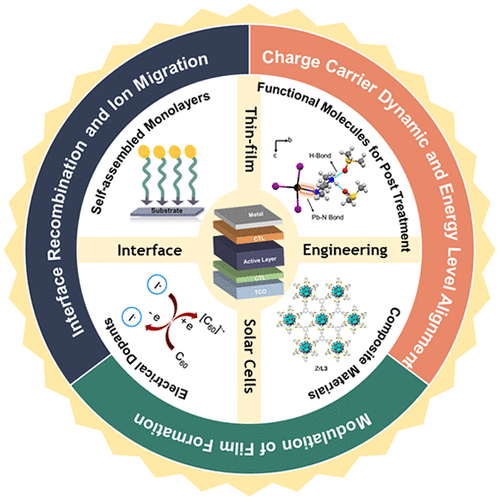当前位置:
X-MOL 学术
›
Acc. Mater. Res.
›
论文详情
Our official English website, www.x-mol.net, welcomes your
feedback! (Note: you will need to create a separate account there.)
Interface Engineering in Solution-Processed Thin-Film Solar Cells
Accounts of Materials Research ( IF 14.0 ) Pub Date : 2022-02-28 , DOI: 10.1021/accountsmr.1c00169 Fengzhu Li 1, 2 , Alex K.-Y. Jen 2, 3, 4
Accounts of Materials Research ( IF 14.0 ) Pub Date : 2022-02-28 , DOI: 10.1021/accountsmr.1c00169 Fengzhu Li 1, 2 , Alex K.-Y. Jen 2, 3, 4
Affiliation

|
Along with the rapid industrialization of human society over the past century, incessant energy consumption and endless damage to the environment have aroused growing attention for seeking clean and renewable energy sources. Photovoltaics (PV) that can directly harvest and transform sunlight into electricity have shown great potential in achieving this goal. Especially for solution-processed thin-film solar cells, their extremely cost-effective and facile processing methods compatible with different substrates at large scales exhibit unique advantages over conventional PVs based on crystalline silicon. Various types of solution-processed thin-film PVs have been achieving or already exceeded 15% power conversion efficiency (PCE) through the numerous efforts of researchers. Organic solar cells (OSCs) and organic–inorganic hybrid perovskite solar cells (PVSCs) are the most well-known emerging solution-processed thin-film solar cells that have attracted great interest recently (the PCE of PVSCs soared form 3.8% to over 25% in the past decade). Usually, photogenerated excitons will form as a response to illumination in the active layer, then dissociate into charge carriers, travel in between layers, and finally get collected by electrodes of the device. Besides the broad exploration of active layer materials, suitably matched charge-transporting layers and electrodes also play a vital role in achieving high PCE and stability in PV devices. Furthermore, interfaces between different functional layers created during solution processing need to be carefully addressed to ensure efficient charge transport and prevent degradation. The utilization of proper interfacial materials to modify the chemical and electrical properties at interfaces has become an effective strategy to enhance the performance of PV. Therefore, it is important to develop a comprehensive understanding into the correlation between interfacial properties and charge carrier dynamics and establish molecular design principles for interfacial materials to realize commercialization of emerging PVs.
中文翻译:

溶液处理薄膜太阳能电池中的界面工程
近百年来,随着人类社会的快速工业化进程,不断的能源消耗和对环境的无休止破坏越来越引起人们对清洁和可再生能源的关注。可以直接收集太阳光并将其转化为电能的光伏 (PV) 在实现这一目标方面显示出巨大的潜力。特别是对于溶液处理的薄膜太阳能电池而言,其极具成本效益且易于大规模兼容不同基板的处理方法与传统的基于晶体硅的 PV 相比具有独特的优势。通过研究人员的大量努力,各种类型的溶液处理薄膜光伏已达到或已经超过 15% 的功率转换效率 (PCE)。有机太阳能电池 (OSCs) 和有机-无机杂化钙钛矿太阳能电池 (PVSCs) 是最著名的新兴溶液处理薄膜太阳能电池,最近引起了极大的兴趣(PVSCs 的 PCE 从 3.8% 飙升至超过 25 % 在过去十年中)。通常,光生激子将作为对有源层中光照的响应而形成,然后分解成电荷载流子,在层间传播,最后被器件的电极收集。除了对活性层材料的广泛探索外,适当匹配的电荷传输层和电极也在光伏器件中实现高 PCE 和稳定性方面发挥着至关重要的作用。此外,在解决方案处理过程中创建的不同功能层之间的界面需要仔细处理,以确保有效的电荷传输并防止退化。利用适当的界面材料来改变界面处的化学和电学性质已成为提高光伏性能的有效策略。因此,全面了解界面性质与电荷载流子动力学之间的相关性并建立界面材料的分子设计原则以实现新兴光伏的商业化非常重要。
更新日期:2022-02-28
中文翻译:

溶液处理薄膜太阳能电池中的界面工程
近百年来,随着人类社会的快速工业化进程,不断的能源消耗和对环境的无休止破坏越来越引起人们对清洁和可再生能源的关注。可以直接收集太阳光并将其转化为电能的光伏 (PV) 在实现这一目标方面显示出巨大的潜力。特别是对于溶液处理的薄膜太阳能电池而言,其极具成本效益且易于大规模兼容不同基板的处理方法与传统的基于晶体硅的 PV 相比具有独特的优势。通过研究人员的大量努力,各种类型的溶液处理薄膜光伏已达到或已经超过 15% 的功率转换效率 (PCE)。有机太阳能电池 (OSCs) 和有机-无机杂化钙钛矿太阳能电池 (PVSCs) 是最著名的新兴溶液处理薄膜太阳能电池,最近引起了极大的兴趣(PVSCs 的 PCE 从 3.8% 飙升至超过 25 % 在过去十年中)。通常,光生激子将作为对有源层中光照的响应而形成,然后分解成电荷载流子,在层间传播,最后被器件的电极收集。除了对活性层材料的广泛探索外,适当匹配的电荷传输层和电极也在光伏器件中实现高 PCE 和稳定性方面发挥着至关重要的作用。此外,在解决方案处理过程中创建的不同功能层之间的界面需要仔细处理,以确保有效的电荷传输并防止退化。利用适当的界面材料来改变界面处的化学和电学性质已成为提高光伏性能的有效策略。因此,全面了解界面性质与电荷载流子动力学之间的相关性并建立界面材料的分子设计原则以实现新兴光伏的商业化非常重要。











































 京公网安备 11010802027423号
京公网安备 11010802027423号